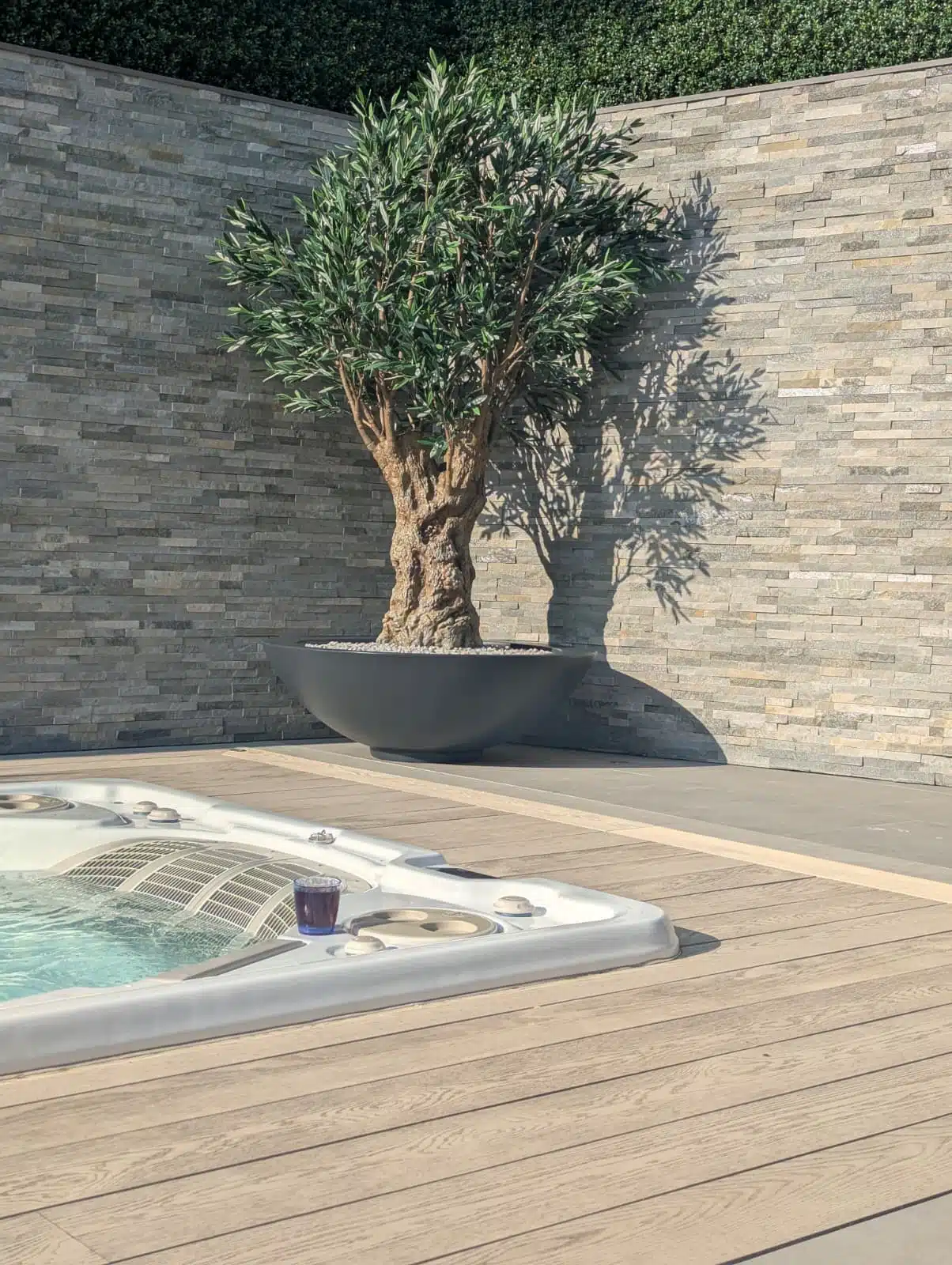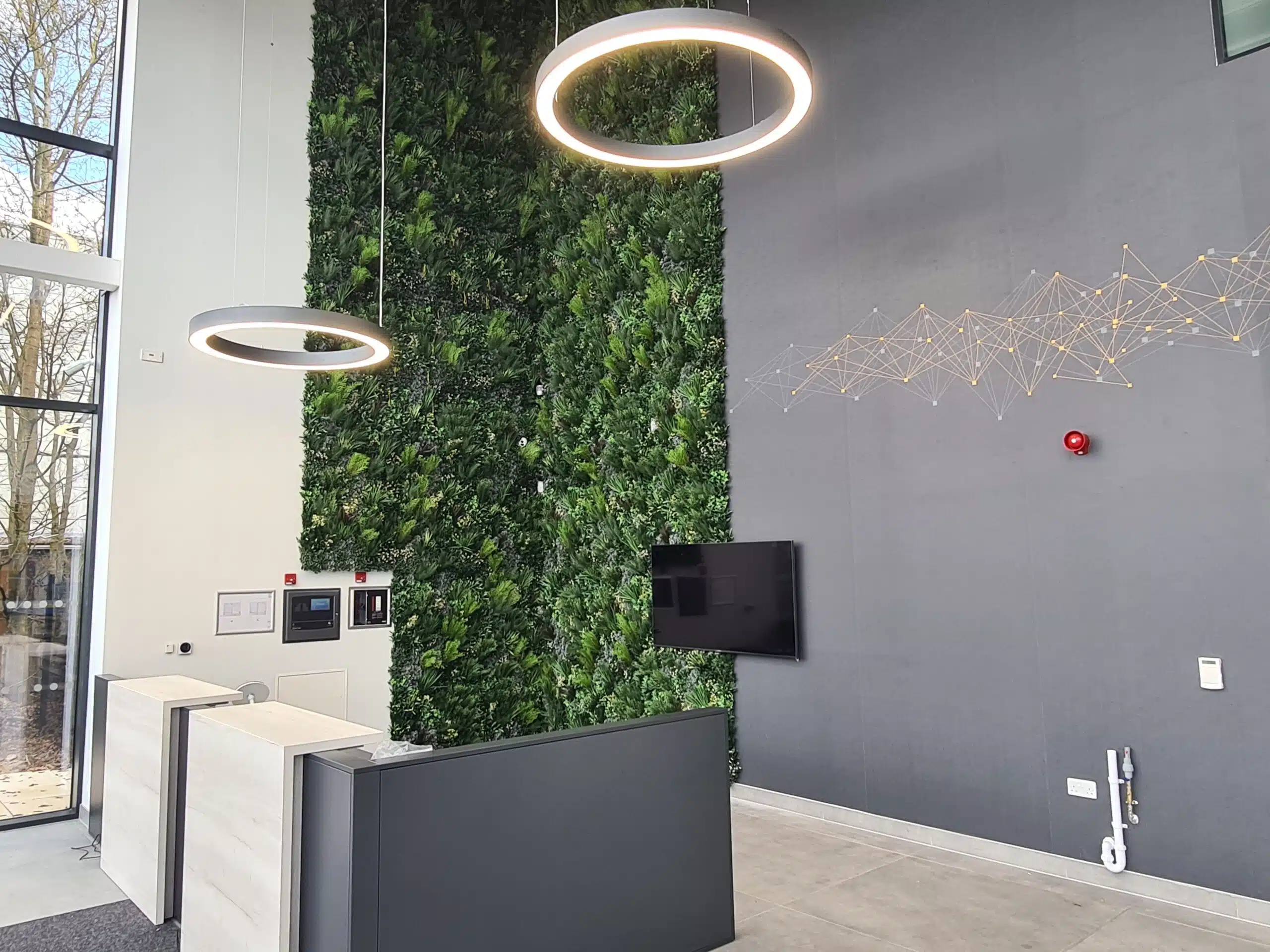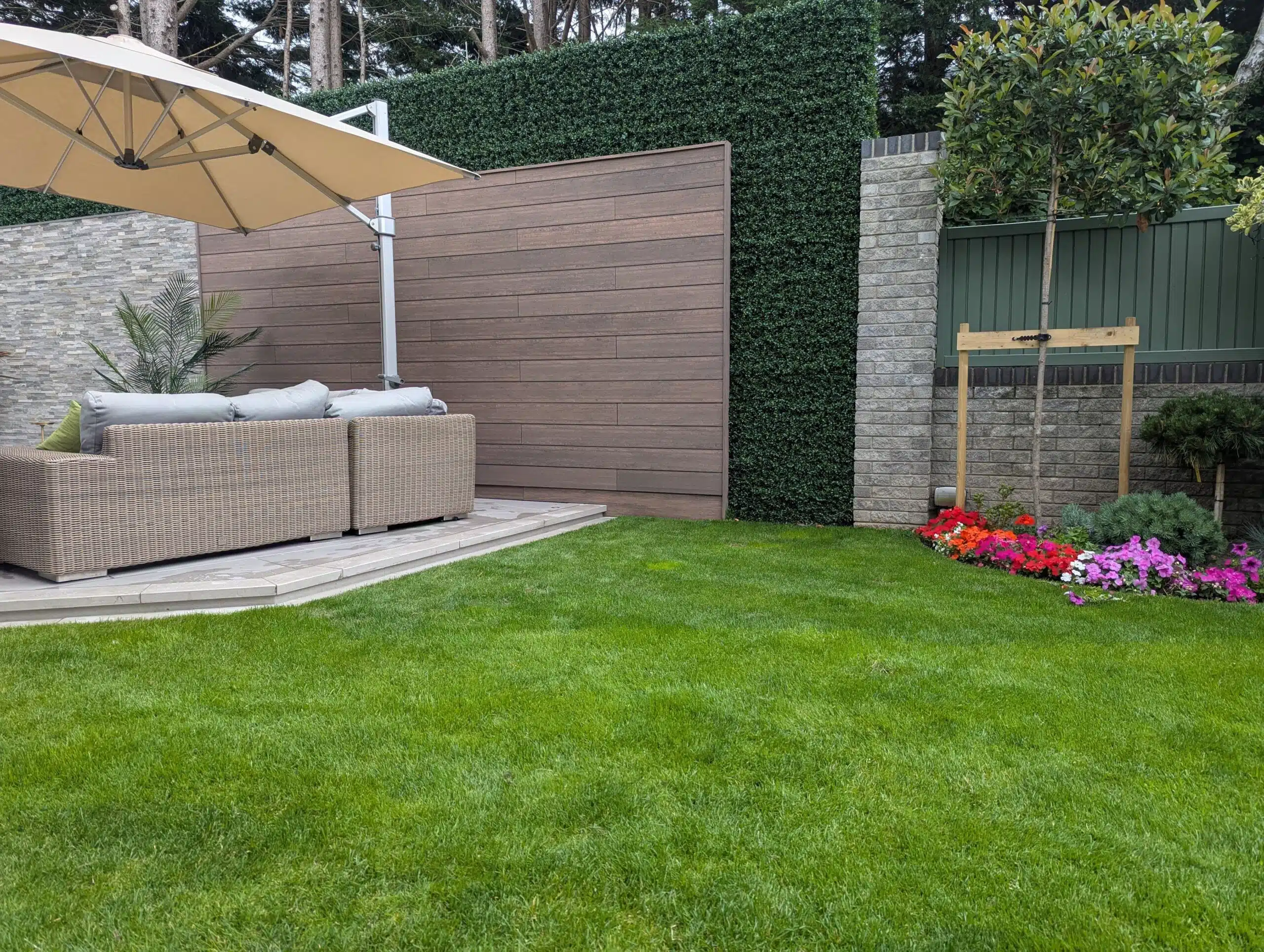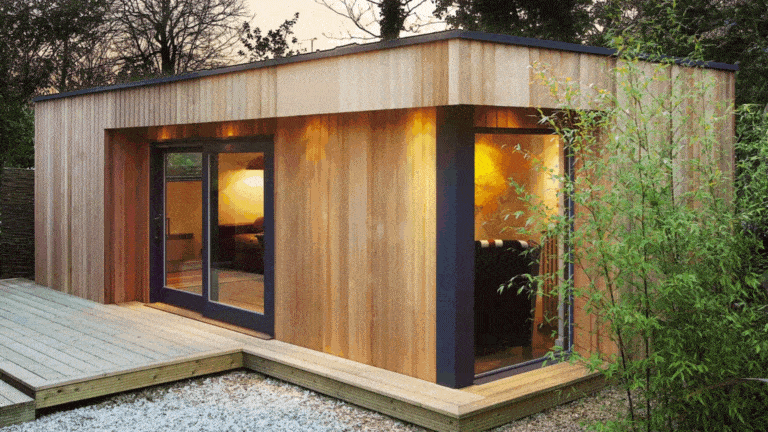Green walls integrate nature into the built environment in a highly systematic and visual scheme meant to provide sensory stimulation, screening or a refresh to featureless surroundings. Two approaches to green wall systems are consolidating within the design and architecture sectors. The traditional approach, living walls, idealise the urban greening impulse but are complicated to construct and maintain. The novel system, artificial green walls, on the other hand, provide a practical, cost-effective solution. Recent developments point to an emerging appreciation for artificial green walls to address the challenge of incorporating natural effects in buildings and living and work spaces. Sustained droughts across the world increase maintenance of real planting and reinforce the need for water conservation, prompting consumers to seek viable alternatives in artificial lawns and green walls. Financial pressures add to the attractiveness of artificial systems, which come at a fraction of the cost of living walls. Time-poor households and busy professionals likewise recognise the practicality and ease of low-maintenance artificial green walls.
Why Artificial?
While purists may hesitate to engage with ‘artificial’ people are increasingly drawn to both the aesthetic and functional benefits of artificial green walls. Ultra-realistic artificial green wall systems such as Vistafolia, which perfectly capture the colors, textures and movements of plants, evoke natural forms in a breathtaking manner, providing as direct an experience of nature as a living wall. With high-quality solutions like Vistafolia, patently fake living walls have become a thing of the past. ‘Artificial’ is also a misnomer when considering what constitutes biophilic design, which fundamentally is about a new consciousness of nature, incorporating natural elements and those mimicking nature, into architecture and structures in an integrative process that promotes human well-being. Indirect experiences of nature –natural geometries, natural colors, naturalistic shapes and forms– likewise reconnect people with nature. Artificial systems as Vistafolia, which look and feel like the real thing, provide a sustained and uplifting affiliation with nature. A lush, invigorating artificial green wall in an office setting, for example, fulfills the requirements of biophilic design better than isolated insertions of nature, such as a scattered, potted planting.
The (Huge) Problem With Living Walls
While artificial green walls have evolved aesthetically to rival living walls, their premium value remains in their many, functional and cost-effective benefits. However much we romanticise nature, there is still no getting around the costs – time, financial and structural – of a natural green wall. A real green wall is a high-maintenance, high-commitment project, full stop. A comprehensive review and understanding of the effort and cost involved should be undertaken by any homeowner or enterprise before construction. First, there are structural, load-bearing issues to consider. A living vertical garden, with soil, planting and frame, has to be ably supported by the host surface, to avoid damage to the building structure. Living green walls are either composed of irrigated planting modules attached to a frame separated from the wall with an air gap and fibrous membrane (often felt or mesh), or supported by a trellis system up a wall, where pre-vegetated panels adhere. Hydroponic systems are pre-vegetated off-site and attached to a framework on the host surface. Substrate- or soil-based systems use moulded containers with substrates of recycled materials and nutrients that support planting and are attached to the host surface. Structural overloading is a real danger when factoring in the weight of all these structures, including for moisture retention. When putting up a living wall system, there should be a careful review of load elements such as the weights of plants, soil, fabric mats and specialised membranes, drainage layers and modular panels. It is important to factor in the weight of the plants when fully grown, as these can be significantly more than upon installation. The condition of the host surface must also be evaluated. In large green walls, wind uplift can be a damaging factor for a wall. Other sources of potential wall structure breaches are cable tension and human access (especially for maintenance). The living wall has to be designed keeping in mind plant root behaviour and plant growth, a task that may well require costly professional expertise. The inability to control these factors can lead to maintenance problems, a messy installation and a potential, cost-accumulating redo.
Bigger Carbon Footprint: Living Walls Use Up Energy
A living wall likewise needs proper watering and sunlight. Living walls are highly susceptible to plant failure without due oversight. Kinks in the irrigation system or lighting issues can turn the most breathtaking vertical gardens into a sorry backdrop. Moreover, the environmental costs of maintaining living green walls can negate its intended ecological benefits. Some engineered living-wall technologies use up massive amounts of energy to supply indoor light or circulate water, air and nutrients throughout the system. Apart from the initial cost of real plants and construction of the wall, living green wall systems need a maintenance budget, often with costly professional hires, to keep the installation looking vibrant and fresh year-round. Without the proper maintenance commitment, especially for areas difficult to reach, plant failure can leave bare or dried patches that may be tricky to remedy without affecting the integrity of the scheme. Living walls are prized for the breadth of their green coverage. But, in a practical sense, the higher the living wall, the greater the challenge for upkeep and access.
Other Costs to Consider With Natural Green Walls
Besides these basic considerations, living walls are also prone to moulding and moisture problems. Particularly for interior placements, careful airflow design must be implemented to ensure that harmful moulds are inhibited and do not damage the surrounding structures. Such entails separating the green wall from the host surface with an air gap, which consume larger space. It is also well worth noting that the supposed potentials of living walls for stormwater retention, where plants act as cleansing agents, have not been realised yet with current systems. And while green walls are celebrated for their pollutant-removing properties, they can also be a source of health-compromising particles and organisms, such as pollen (careful plant selection is crucial for living walls) and disease-bearing insects. Artificial green walls reduce young children’s exposure to these potentially harmful agents. Adult family members with sensitive medical conditions are better protected as well.
Artificial Green Walls: The Practical Greening Solution
Simply put, without due care, a living wall can fail, and fail spectacularly, with plants dying in as fast as a few weeks from installation. Artificial green wall systems pose the practical, low-risk, low-maintenance alternative, handily eliminating all of the problems associated with real green walls. For one, artificial green walls have fewer weight issues than living green walls. Systems calibrated for maximum lightness, such as Vistafolia, practically take off the load from host surfaces and existing structures. Trellises and living-wall panels hold pre-vegetated material that includes soil, peat and planting, and this ‘dead load’ (the final weight of all constructed elements) needs to be supported by the existing structural capacity of the host surface or building. In marked contrast, artificial green wall systems usually are composed of lightweight frames, such as stainless steel grid panels, to which the artificial foliage are attached. Vistafolia’s signature panels weigh just seven kilograms and can be easily manipulated into place at great heights. Apart from the live and transient loads of people working on the installation and any equipment used, there are practically no load-bearing concerns at all.
Irrigation and Lighting Worries Solved
With artificial green walls, maintenance is kept to a minimum, with the occasional dusting and cleaning with light pressure from a water hose. There is no worry over faulty irrigation systems or the need to comprehend complicated, engineered systems with tanks and valves and nutrient delivery mechanisms. There is also no need to install equally complex, energy-consuming lighting applications to supplement available natural light. (Supplemental lighting, in itself, has more complications. The planting composition not only dictates the type of light to be used, but also the light spectrum. Leafy, non-flowering plants prefer ‘cool’ blue light to thrive; flowering plants respond to red light. Complex lighting systems are an additional expense.) When the two major issues of irrigation and sunlight are eliminated, the possibilities for designing better green environments increase. An artificial green wall can be installed anywhere, in a basement stairwell, under a bridge, throughout the length and breadth of a city terrace wall, unmindful of irrigation installation space considerations or design and placement issues arising from inaccessibility to natural light. Many living green wall projects are cancelled due to low-light levels on-site, leaving clients where they started – with a dull, unwelcoming façade that direly needs refreshing. Similarly, more ambitious greening projects have been put on hold when faced with the extent of the irrigation mechanism required.
Efficient Installation, Cost-Effective Solution
Living green walls, with all the materials and equipment needed, often require professional installation. Artificial systems using only stainless steel grid panels can be installed without outside help, especially for small home projects such as a living room installation. Vistafolia’s extensive research and development has resulted in an incredibly flexible and easy design, with the grid panels customisable to fit any surface dimension (panels can be re-sized with just a cutter, cutting along the standardised grids). The lightweight panels can be fixed niftily onto any wall surface and fixed with Vistafolia’s unique drill-and-cap system that’s as DIY easy as putting up a painting or a wall shelf. The process is by-the-numbers straightforward that bigger walls can feasibly go up in as little as a day’s installation. One striking advantage of artificial green walls over living walls is cost. In fact, the cost difference between the two is significant and can very well be the dealmaker for artificial vertical garden systems. One square meter of a natural green wall can cost as much as £1,000 to design, supply and install. By comparison, Vistafolia’s artificial green wall panels are much more cost effective. Especially for large commercial projects, the cost savings for artificial green walls are considerable. Even when initial outlays are sizable, artificial green wall expenditures remain value for money. Apart from monthly maintenance costs for water and energy consumption and professional upkeep, natural green walls come with many hidden costs – for failing plants and planting redesign and assorted troubleshooting. These costs, subject no less to inflation pressures, can add up, overburdening already squeezed budgets.
Lush, All-Purpose Green Walls
The aesthetic benefits of artificial green walls, then, have a kind of multiplier effect. No project is too big or unfeasible when using an exceptionally flexible artificial green wall solution like Vistafolia’s, which can address any design or site requirement with commendable ease and speed. Creativity and personalisation are enabled. Vistafolia’s signature panels can be customised according to preference with our Colour Box system of tonal plant mixes that can change and refresh the look of the installation instantly. With individual plants ranging from classic greens, wild grasses, lavenders, snowballs and delicate blooms, our signature panels can be wonderfully bespoke according to mood and taste, encouraging our clients to be happy co-creators of our unique and innovative design solution. When designed intelligently and with a passion for horticulture and plants, artificial green wall systems can provide breathtaking green coverage that pleases the eye and create wonderful green environments. A perpetually lush wall that looks as good as the real thing is a truly inviting prospect. The dependability and permanence of artificial green walls can qualify as an aesthetic virtue that trumps any question over the ‘natural’ aspect. While living green walls can fail at the slightest hiccup in a complicated irrigation system, an artificial green wall will look as verdant as the green of the primordial jungle from day to day, with no unsightly brown areas or leggy patches needing emergency relief. To maintain our foliage’s colour vibrancy, Vistafolia devoted long hours of research and development to ensuring its signature panels have been rigorously tested for UV stability. Vistafolia panels are UV-tested to BS EN ISO 4892-2 : 2013 for 3000 hours. This means that the panels have been tested in the presence of xenon-arc light, with moisture, to reproduce the weathering effects of exposure to daylight, whether direct or filtered through window glass. The panels can withstand temperature, humidity and wetting effects of exposure under the sun. UV stability minimises fading. Vistafolia foliage panels come with a three-year warranty. Artificial green walls not only provide attractive cladding for dull, featureless walls or unsightly, problem areas, the coverage can also help protect the host surface from environmental pressures such as destructive UV light, wind or frost damage. The screening solution thereby has double utility for extending the life of the underlying structure. Vistafolia’s signature panels are also wind- and freeze-tested. With customer and environmental safety in mind, top of the line manufacturers like Vistafolia take great pains to ensure fire retardancy for its artificial foliage panels. Vistafolia panels have been tested repeatedly in UK laboratories and are fire-tested to BS EN ISO 11925-2:2010, meaning it has been tested to ignitability from a single small flame source, and certified to BS EN ISO 13501-1:2007+A1:2009, Fire classification of construction products and building elements. The panels are certified safe for interior placement.
Why Not Artificial?
Vistafolia founder Paul Alder succinctly captures the rationale for artificial green wall systems: ‘As a garden designer and horticulturalist with 25 years experience of building gardens for prestige commercial and residential projects, I realised that there was a demand for a flexible system that created the look of beautiful vertical green-wall planting without the hassle of using real plants that require natural light or ongoing maintenance. ‘We approached the challenge to create a product that is not only as good as a natural wall, but better. Developing our unique system has ensured that Vistafolia is the number one artificial vertical garden solution.’ Artificial vertical gardens create wonderful green vistas, at a fraction of the cost and effort of living walls, to perk up any home, office or commercial environment. They are the perfect examples of how ‘artificial’ can be an incredibly good proposition, and not antithetical to nature at all. Biophilic design emphasises human adaptations to the natural world in response to the biological imperative for health and well-being. Artificial green wall systems are human innovations that respond to our natural urge for self-preservation and self-improvement. In this sense, they are a natural response to natural circumstances. Further, with their resilience and practicality, artificial green walls can better promote people’s sustained engagement with nature, enabling and reinforcing man’s need to affiliate with elements of the natural world far better than ill-planned or disconnected provisions of real nature. Like living walls, artificial green walls nurture people’s emotional connections to their environments, creating positive, pleasing living and work spaces that motivate people to improve relationships, productivity and outcomes. Unlike living walls, artificial green walls do not need any nurturing in turn. In the case of artificial green walls, ‘not occurring in nature’ becomes a huge benefit, celebrating how human interventions can improve on what does occur naturally, simplifying the complex and creating better environments. Far from skepticism, ‘artificial’ should be lauded, especially in the case of practical greening.

The Ultimate Artificial Olive Tree Indoors and Outdoors Buyer’s Guide

6 Inspirational Indoor Plant Walls Ideas

Why a Fake Ivy Wall Might Be the Upgrade Your Space Needs

